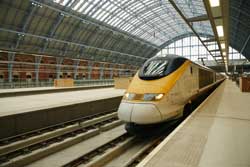
Posted to News on 14th Sep 2008, 12:53
Mitsubishi helps Eurostar trains run safely under London
Mitsubishi Q series PACs and an MX4SCADA system are being used within safety-critical control systems for the Cross London Channel Tunnel Rail Link.

Ventilation and safety for the new Cross London Channel Tunnel Rail Link is controlled by a dual-redundant system of programmable automation controllers (PACs) that link into the supervisory control and data acquisition (SCADA) system located at the Eurostar control centre in Ashford, Kent.
There are three new tunnels on the new high-speed link that runs from Ebbsfleet in North Kent to the newly refurbished St Pancras station in London, passing under central London and the River Thames. The tunnels are twin bore, one for each direction of travel, with regular cross passages that facilitate escape to safety in the event of an incident.
Ventilation and escape/access are the keys to tunnel safety and Rail Link Engineering entrusted the control system for this to Johnson Controls, which selected Mitsubishi Electric as its key technology supplier. Several different architectures were considered for the project, the one finally selected being a unified dual-redundant network running all the way from the Ashford control centre to St Pancras and back again.
Easy implementation of redundancy
Johnson Controls' Ian Spencer explains the details: "The whole system is based on Mitsubishi's MX4SCADA and Q series PACs. These are high-performance, state-of-the-art PLCs (programmable logic controllers), designed for use in large, complex systems and the most demanding applications.
"One of their great advantages for this job is that that they are easy to set up in a redundant or standby configuration. Previously such belt-and-braces systems were very expensive to implement but, with the Q series, costs are barely more than those for a conventional system"
A pair of PACs, configured in warm standby mode, are assigned to control the main tunnel ventilation fans at each of the 11 portal/shaft locations throughout the length of the tunnels. These fans are used to move smoke away from an incident train in one tunnel bore and pressurise the other tunnel bore to create 'a place of relative safety' to which passengers and train crew can escape.
Although the fans are generally used for cooling of trains during periods of congestion (a bespoke interface between MX4SCADA and the signalling system was developed to allow the MX4SCADA to monitor train positions) and to provide ventilation for maintenance teams in the tunnels, they have to be able to be configured in one of many hundreds of possible ventilation modes, dependant upon the 'incident' train's position, at a moment's notice. This ability is tested regularly through the PACs' pre-programming.
Along with the bespoke interface with the signalling system, there is a bespoke interface with the EMMIS (Electrical and Mechanical Information System). The status and position of cross-passage doors and other essential equipment within the cross-passages is sent to EMMIS from the MX4SCADA system.
Passenger safety
A critical part of the tunnel's safety regime is the cross passages. If an incident occurs in one tunnel, they allow the passengers rapid egress to the other - and ultimately to escape from danger. There are frequent cross-passages so that evacuation can be rapid and safe, no matter where in the tunnel the incident occurs.
The Mitsubishi control system is designed to maintain a positive pressure in the cross-passages, so that they can be guaranteed clear of smoke in all events. The fans for ensuring this safety-critical function are again controlled by warm-standby pairs of Q series PACs. The cross-passage door positions are monitored 24/7 by Q series PACs on a dual-redundant Melsec 10 network that connects back to the warm-standby PACs.
It is inevitable that all major tunnels are likely to have low-lying points where water may gather, causing a nuisance, hygiene risk or local flooding. To overcome this, Rail Link Engineering has installed banks of large pumps in several susceptible locations. These are all controlled by Mitsubishi variable-speed drives integrated into the pumps' control network.
Ian Spencer states: "We considered putting the pumps on a dedicated network, but the advantages of integration are significant. Maintenance of a single system is far easier, and condition monitoring of the environment and technical systems is straightforward."
* Photo courtesy of LCR/Hugo Dixon.
Want the latest machine building news straight to your inbox? Become a MachineBuilding member for free today >>


















